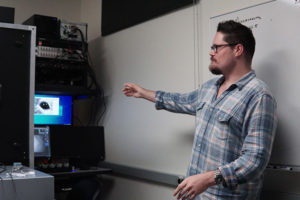
As humans, our senses, such as hearing, influence how we perceive and recognize the world around us. For example, most everyone has experienced the phenomenon of hearing a certain song and instantly being transported to a specific memory of their life. Researchers in the Department of Otolaryngology, however, are now trying to determine how what we hear can also influence how we behave.
How Can Hearing Affect Our Behavior?
“Our ability to make decisions based on changes in the auditory environment often involves the accumulation of sensory evidence, where newly acquired information is used to update existing beliefs and drive future actions,” says Ross Williamson, PhD, Assistant Professor of Otolaryngology and Neurobiology at the University of Pittsburgh School of Medicine. “For example, the sound of sirens when driving leads to both an accumulation of sensory evidence as to their location as well as their relative importance. Combined, this leads to a decision regarding the correct motor action to take (whether or not, and where, to pull over),” explains Dr. Williamson.
Dr. Williamson and other members of the Pittsburgh Hearing Research Center are now studying the flow of sensory information throughout the brain so that they can understand the neurobiological circuits that underlie sensory decision making. Using a mouse model, Dr. Williamson utilizes a state-of-the-art procedure to look through a “window to the brain” to see neurological reactions to sound in real-time. Dr. Williamson and his team believe that the organization of corticofugal networks provides a means for routing and coordinating the flow of behaviorally-relevant sensory information to a variety of downstream targets.
Where Will This Research Lead?
The Department’s goal is to describe a set of corticofugal organizational principals and how those principals affect perception and purposeful behavior. In practical terms, these corticofugal circuits are already implicated in the generation of perceptual disorders, from the perception of sounds that do not exist (tinnitus and schizophrenia) to the irrepressible awareness of unwanted or distracting sounds (attention deficit hyperactivity disorder). Dr. Williamson’s work will play a crucial role in generating insights regarding which neural circuits should be targeted to maximize subsequent therapeutic benefit. “Current therapies typically treat symptoms but do not repair underlying brain dysfunction,” states Dr. Williamson. The hope is that a detailed knowledge of the circuitry involved in perceptual disorders will lead to new interventions whereby healthy patterns of activity can be guided or reinforced in order to repair the function of damaged neural circuits.
This type of innovative research is only possible with support from generous donors to the Eye & Ear Foundation. If you would like to be a part of this groundbreaking work being done, please consider making a gift to help support our research.
To stay up to date on future events and news, follow EEF on Facebook, Twitter, and LinkedIn and subscribe to our Sight + Sound blog.